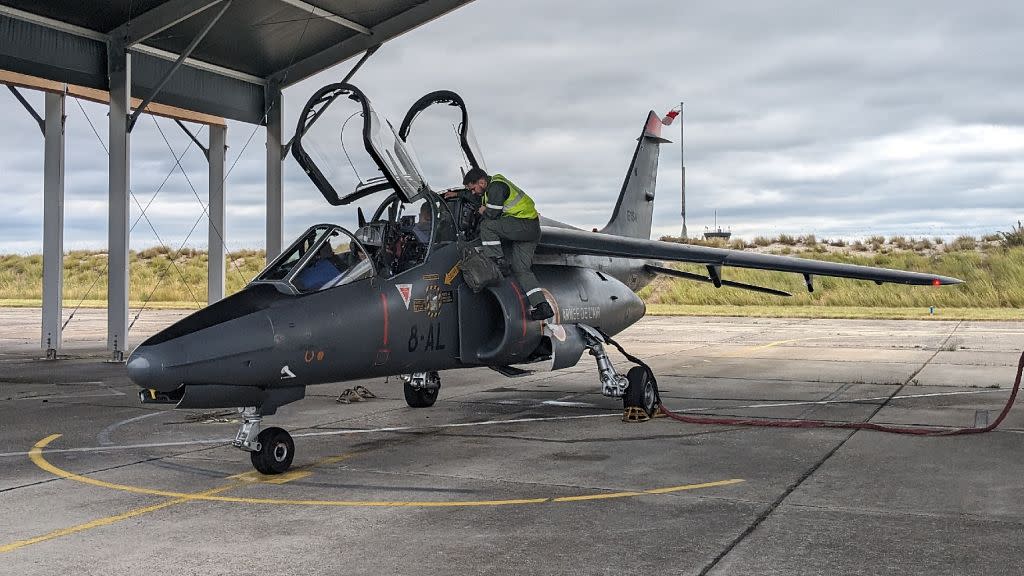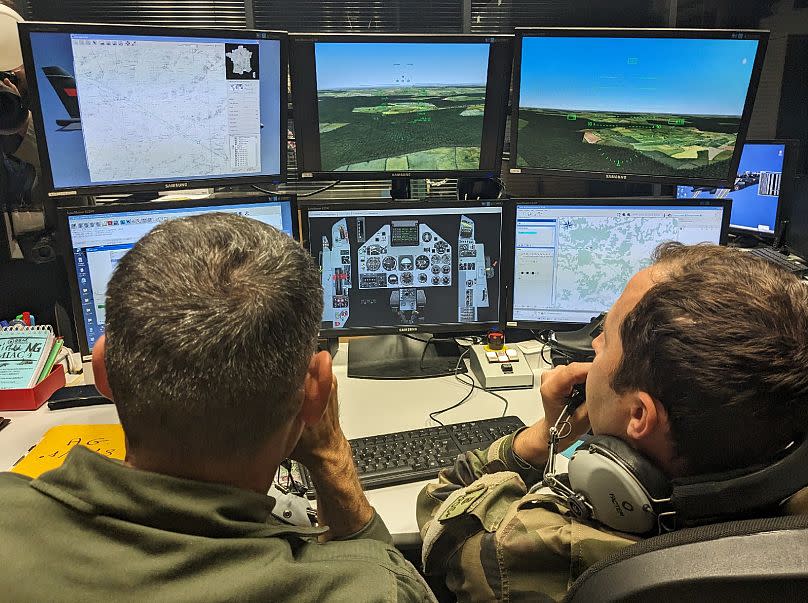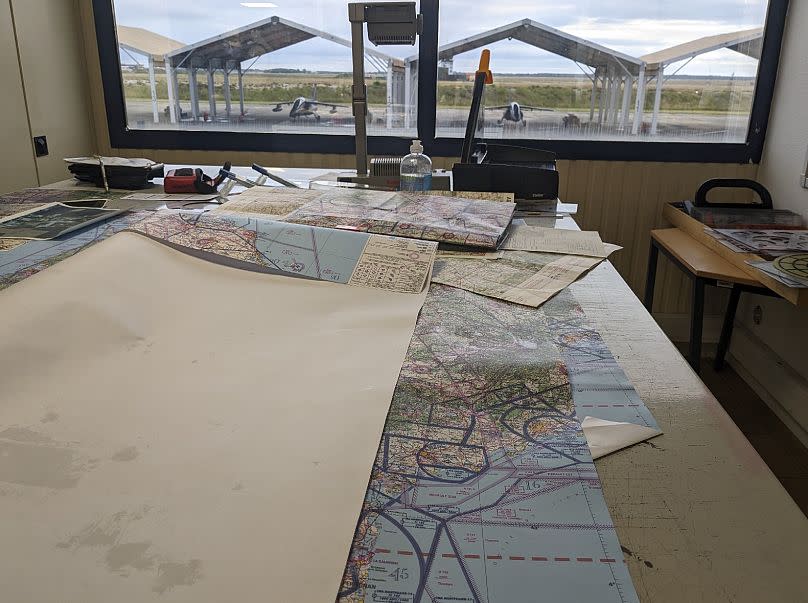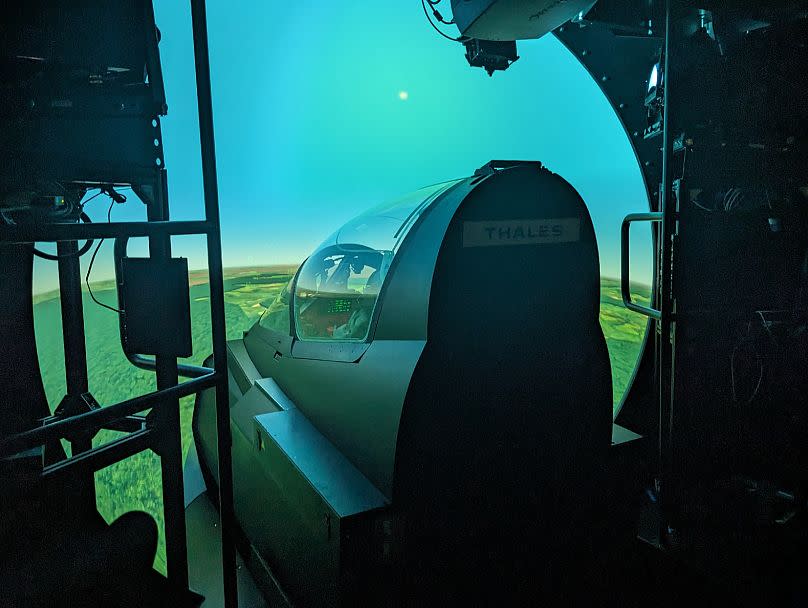In southwestern France, Ukrainian pilots are learning to fly fighter jets

- Oops!Something went wrong.Please try again later.
"You’re at the gate, about to cross the enemy line. Drop to below 500 feet," one of two French Air Force instructors says.
Immediately a 3D rendering of the fields, forests and villages of the French countryside on multiple screens in front of them becomes sharper. Just under fifteen minutes later, they give the command to the Ukrainian soldier in a fighter jet simulator in the adjacent room to hit release and bomb his target.
His mission, plotted earlier in the morning using various maps, satellite images, weather forecasts and made-up data of where enemy equipment was supposedly last seen, was to hit a Russian ammunition depot.
There is no such thing in France, but châteaux are a dime a dozen and one is turned into today’s scapegoat.
Another of the soldier’s 10 comrades also receiving pilot training on the southwestern French base is carrying out the same fake mission, but he’s taken to the skies onboard a real warplane.
But it’s just as well he didn’t go airborne. By the time he had crossed the “gate” he was three minutes behind schedule - an enormous gap given time allowance is more or less 10 seconds - and his approach and bombing of the target was not up to par.
“Let’s freeze,” the instructor, whose name is withheld for security reasons, says. “We go back one minute and you do it again.”

A three-phase training programme
Ukrainian President Volodymyr Zelenskyy started asking allies to donate warplanes and deliver pilot training to his armies within days of Russia launching its full-scale invasion of the country in late February 2022.
But the 10 Ukrainian pilots currently in France are the first batch to receive a six-month training there. Before that, they were in the UK and after, they’ll likely head to Romania for the third and final phase of training.
During the several months they spent in the UK, each one spent about 70 hours operating a GROB-115 aircraft, an easy-to-handle general aviation aircraft with a maximum speed of about 220 km/h.
In France, they’ve graduated to an Alpha Jet plane, a light attack jet and advanced jet trainer with a top speed of over 900 km/h that they will man for about 80 hours in the air with an additional 60 hours in a simulator. In Romania, they can expect to pilot F-16s - the American-made supersonic fighter jet with a 2,100 km/h top speed - for 60 hours.
Then, they’ll return home where it is hoped their newly acquired skills can help tip the war to Ukraine's advantage.
Western vs Soviet mentality
The precise location of the training and the identity of the instructors are kept under wrap because “we have very real, very clear warnings about people who are trying to obtain intelligence or take strong action against this training,” Colonel Yann Malard, the director of French Air and Space Force Public Affairs, told reporters during a one-day observation trip for media last week.
Euronews was not allowed to speak to any of the Ukrainian soldiers but “they are very receptive and motivated,” the colonel commandant of a French air force base stressed to Euronews, adding that “they very much see the benefit of doing this".
This includes learning to prep their mission, briefing it, navigating with or without GPS, including at very low altitudes, dropping bombs and flying in formation, the latter of which is a core Western tenet.
In fact, one of the main tasks for the French trainers - which include active duty instructors, so-called “subscribers” or former pilots now in the état-major, as well as reservists - is to replace any Soviet-style teachings these young pilots might have received with Western modus operandi.
“The way the Ukrainians have been trained and the way the missions are conducted on the Western side is radically different. On the Western side, pilots are given a great deal of autonomy to make decisions and carry out their mission,” the colonel commandant told Euronews.
“In the Russian world, the pilot is more an effector for someone on the ground, who is in front of a radar and who might tell them ‘go right, go left’ (...) and that’s quite a radical change. And when you’re used to doing it in a different way, well, it’s a real challenge,” he added.

'They might not go over the gates'
Whether the Ukrainian Air Force ends up keeping these modi operandi is another matter and as this is the inaugural training programme, there is no feedback yet from the Ukrainians.
“It's not necessarily tactical and they might not go over the gates and fly over occupied territory,” Lieutenant-Colonel François (name withheld), who is in charge of the training, told Euronews.
The Ukrainian état-major might, for example, decide that the cost of losing such an expensive and sparse piece of equipment is too high. Euronews contacted the Ukrainian Air Force Command but had not received an answer by the time of publication.
According to the Oryx Blog, which keeps track of losses on the battlefield by verifying visual documentation, Moscow has destroyed 75 Ukrainian aircraft and damaged two more since the start of its full-scale invasion. This constitutes a very large chunk of the roughly 100 Soviet-made MiG-29, Su-24 and Su-25 fighter jets the country had before Russia launched its unprovoked attack.
Kyiv, meanwhile, has successfully downed 92 Russian combat aircraft and damaged an additional four.
“But we teach it to them because it's interesting from an educational point of view,” the Lieutenant-Colonel added.
This includes shooting, which they will soon practise over and over again with 30mm calibre ammunition on a dedicated site so that if they’re ever sent on a mission to neutralise an enemy target, they’re mentally prepared.
“(The plane) vibrates all over when you shoot, so they won’t be surprised. And they will already have had the psychological experience of having something leave the plane,” he also said.

French warplanes heading to Ukraine
Poland and Slovakia have already helped replenish Ukraine’s warplane arsenal by donating multiple MiG-29 warplanes. Belgium, Denmark, the Netherlands, Norway, and now France have all pledged to send Western warplanes, F-16s for the first four, and Mirages 2000-5s for the latter.
French President Emmanuel Macron announced the pledge earlier this month following the D-Day commemorations in Normandy that Zelenskyy attended. Yet it is still unclear how many aircraft will be provided.
France has 26 Mirages 2000-5s, which have a top speed of about 2,300 km/h and which the country uses primarily in a defensive capacity, to police its skies and that of its allies.
But Macron said that an “international coalition” of donors would be set up - only eight other countries (Brazil, Egypt, Greece, India, Peru, Qatar, Taiwan, the UAE) have this model.
A French Air Force source confirmed that the training and delivery of Mirage 2000-5s has not yet been scheduled but that discussions between France and Ukraine are underway.
For France, which has few of them, the donation will force a reorganisation of its fleet as its Mirages are all deployed and will need to be replaced in squadrons, most likely by more modern Rafales.
But while France has been using them in a purely defensive capacity for decades, Ukraine could in theory use them in a more lethal way.
“Today, in fact, there are hardware, software solutions to enable it to be transformed into a ground attack capacity,” the source said. “In practical terms, this would take a few weeks or months.”
France, which has other warplanes including the Rafale, had decided not to pursue that avenue and confine the Mirage 2000-5 to defence only, “but today, as part of the transfer with Ukraine, this is actually an option."
"That doesn't mean it will happen, but discussions are underway."

